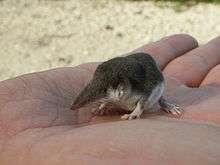List of mammals of Afghanistan
This list of the mammal species in Afghanistan provides information about the status of the 128 mammal species occurring in Afghanistan. Four are endangered, twelve are vulnerable, and five are near threatened.[1] The following tags are used to highlight each species' global conservation status as assessed on the IUCN Red Lists:
| CR | Critically endangered | The species is in imminent risk of extinction in the wild. |
| EN | Endangered | The species is facing an extremely high risk of extinction in the wild. |
| VU | Vulnerable | The species is facing a high risk of extinction in the wild. |
| NT | Near threatened | The species does not meet any of the criteria that would categorise it as risking extinction but it is likely to do so in the future. |
| LC | Least concern | There are no current identifiable risks to the species. |
| DD | Data deficient | There is inadequate information to make an assessment of the risks to this species. |
| EX | Extinct | No reasonable doubt that the last individual has died. |
| EW | Extinct in the wild | Known only to survive in captivity or as a naturalized populations well outside its previous range. |
Order: Primates
The order Primates contains humans and their closest relatives: lemurs, lorisoids, monkeys, and apes.
- Family: Cercopithecidae (Old World monkeys)
- Genus: Macaca
- Rhesus macaque, M. mulatta LC[2]
- Genus: Macaca
Order: Rodentia (rodents)
Rodents make up the largest order of mammals, with over 40 percent of mammalian species. They have two incisors in the upper and lower jaw which grow continually and must be kept short by gnawing. Most rodents are small though the capybara can weigh up to 45 kg (100 lb).
- Suborder: Sciurognathi
- Family: Sciuridae (squirrels)
- Subfamily: Sciurinae
- Tribe: Pteromyini
- Genus: Hylopetes
- Afghan flying squirrel, Hylopetes baberi LC
- Genus: Petaurista
- Red giant flying squirrel, Petaurista petaurista LC
- Genus: Hylopetes
- Tribe: Pteromyini
- Subfamily: Callosciurinae
- Genus: Funambulus
- Northern palm squirrel, Funambulus pennantii LC
- Genus: Funambulus
- Subfamily: Xerinae
- Tribe: Xerini
- Genus: Spermophilopsis
- Long-clawed ground squirrel, Spermophilopsis leptodactylus LC
- Genus: Spermophilopsis
- Tribe: Marmotini
- Genus: Marmota
- Long-tailed marmot, Marmota caudata LC
- Genus: Spermophilus
- Yellow ground squirrel, Spermophilus fulvus LC
- Genus: Marmota
- Tribe: Xerini
- Subfamily: Sciurinae
- Family: Gliridae (dormice)
- Subfamily: Leithiinae
- Genus: Dryomys
- Forest dormouse, Dryomys nitedula LC
- Genus: Dryomys
- Subfamily: Leithiinae
- Family: Dipodidae (jerboas)
- Subfamily: Allactaginae
- Genus: Allactaga
- Small five-toed jerboa, Allactaga elater LC
- Euphrates jerboa, Allactaga euphratica LC
- Hotson's jerboa, Allactaga hotsoni LC
- Genus: Allactaga
- Subfamily: Cardiocraniinae
- Genus: Salpingotus
- Thomas's pygmy jerboa, Salpingotus thomasi DD
- Genus: Salpingotus
- Subfamily: Dipodinae
- Genus: Jaculus
- Blanford's jerboa, Jaculus blanfordi LC
- Genus: Jaculus
- Subfamily: Allactaginae
- Family: Calomyscidae
- Genus: Calomyscus
- Baluchi mouse-like hamster, Calomyscus baluchi LC
- Afghan mouse-like hamster, Calomyscus mystax LC
- Genus: Calomyscus
- Family: Cricetidae
- Subfamily: Cricetinae
- Genus: Cricetulus
- Grey dwarf hamster, Cricetulus migratorius LC
- Genus: Cricetulus
- Subfamily: Arvicolinae
- Genus: Alticola
- Silver mountain vole, Alticola argentatus LC
- Genus: Blanfordimys
- Afghan vole, Blanfordimys afghanus LC
- Bucharian vole, Blanfordimys bucharicus LC
- Genus: Ellobius
- Southern mole vole, Ellobius fuscocapillus LC
- Genus: Microtus
- Juniper vole, Microtus juldaschi LC
- Tien Shan vole, Microtus kirgisorum LC
- Transcaspian vole, Microtus transcaspicus LC
- Genus: Alticola
- Subfamily: Cricetinae
- Family: Muridae (mice, rats, voles, gerbils, hamsters, etc.)
- Subfamily: Gerbillinae
- Genus: Gerbillus
- Swarthy gerbil, Gerbillus aquilus LC
- Gerbillus nanus LC
- Genus: Meriones
- Sundevall's jird, Meriones crassus LC
- Libyan jird, Meriones libycus LC
- Mid-day jird, Meriones meridianus LC
- Persian jird, Meriones persicus LC
- Zarudny's jird, Meriones zarudnyi EN
- Genus: Rhombomys
- Great gerbil, Rhombomys opimus LC
- Genus: Tatera
- Indian gerbil, Tatera indica LC
- Genus: Gerbillus
- Subfamily: Murinae
- Genus: Apodemus
- Ward's field mouse, Apodemus wardi LC
- Genus: Millardia
- Sand-colored soft-furred rat, Millardia gleadowi LC
- Genus: Nesokia
- Short-tailed bandicoot rat, Nesokia indica LC
- Genus: Rattus
- Tanezumi rat, Rattus tanezumi LC
- Turkestan rat, Rattus turkestanicus LC
- Genus: Apodemus
- Subfamily: Gerbillinae
- Family: Sciuridae (squirrels)
Order: Lagomorpha (lagomorphs)
The lagomorphs comprise two families, Leporidae (hares and rabbits), and Ochotonidae (pikas). Though they can resemble rodents, and were classified as a superfamily in that order until the early 20th century, they have since been considered a separate order. They differ from rodents in a number of physical characteristics, such as having four incisors in the upper jaw rather than two.
- Family: Ochotonidae (pikas)
- Genus: Ochotona
- Large-eared pika, Ochotona macrotis LC
- Afghan pika, Ochotona rufescens LC
- Turkestan red pika, Ochotona rutila LC
- Genus: Ochotona
- Family: Leporidae (rabbits,hares)
Order: Erinaceomorpha (hedgehogs and gymnures)
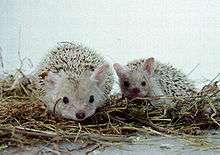
The order Erinaceomorpha contains a single family, Erinaceidae, which comprise the hedgehogs and gymnures. The hedgehogs are easily recognised by their spines while gymnures look more like large rats.
- Family: Erinaceidae (hedgehogs)
- Subfamily: Erinaceinae
- Genus: Hemiechinus
- Long-eared hedgehog, Hemiechinus auritus LC
- Brandt's hedgehog, Hemiechinus hypomelas LC
- Genus: Hemiechinus
- Subfamily: Erinaceinae
Order: Soricomorpha (shrews, moles, and solenodons)
The "shrew-forms" are insectivorous mammals. The shrews and solenodons closely resemble mice while the moles are stout-bodied burrowers.
- Family: Soricidae (shrews)
- Subfamily: Crocidurinae
- Genus: Crocidura
- Gmelin's white-toothed shrew, Crocidura gmelini LC
- Taiga shrew, Crocidura pullata LC
- Lesser white-toothed shrew, Crocidura suaveolens LC
- Zarudny's shrew, Crocidura zarudnyi LC
- Genus: Suncus
- Etruscan shrew, Suncus etruscus LC
- Asian house shrew, Suncus murinus LC
- Genus: Crocidura
- Subfamily: Soricinae
- Tribe: Soricini
- Genus: Sorex
- Eurasian pygmy shrew, Sorex minutus LC
- Genus: Sorex
- Tribe: Soricini
- Subfamily: Crocidurinae
Order: Chiroptera (bats)

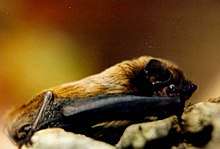
The bats' most distinguishing feature is that their forelimbs are developed as wings, making them the only mammals capable of flight. Bat species account for about 20% of all mammals.
- Family: Vespertilionidae
- Subfamily: Myotinae
- Genus: Myotis
- Lesser mouse-eared bat, M. blythii LC[3]
- Geoffroy's bat, Myotis emarginatus VU
- Hodgson's bat, Myotis formosus LC
- Fraternal myotis, Myotis frater LC
- Kashmir cave bat, Myotis longipes VU
- Whiskered myotis, Myotis muricola LC
- Whiskered bat, Myotis mystacinus LC
- Genus: Myotis
- Subfamily: Vespertilioninae
- Genus: Barbastella
- Eastern barbastelle, Barbastella leucomelas LC
- Genus: Eptesicus
- Botta's serotine, Eptesicus bottae LC
- Gobi big brown bat, Eptesicus gobiensis LC
- Sind bat, Eptesicus nasutus VU
- Serotine bat, Eptesicus serotinus LC
- Genus: Hypsugo
- Savi's pipistrelle, H. savii LC[4]
- Genus: Nyctalus
- Lesser noctule, N. leisleri LC[5]
- Mountain noctule, Nyctalus montanus LC
- Genus: Otonycteris
- Desert long-eared bat, Otonycteris hemprichii LC
- Genus: Pipistrellus
- Indian pipistrelle, Pipistrellus coromandra LC
- Java pipistrelle, Pipistrellus javanicus LC
- Kuhl's pipistrelle, Pipistrellus kuhlii LC
- Common pipistrelle, Pipistrellus pipistrellus LC
- Least pipistrelle, Pipistrellus tenuis LC
- Genus: Plecotus
- Grey long-eared bat, Plecotus austriacus LC
- Genus: Scotophilus
- Greater Asiatic yellow bat, Scotophilus heathi LC
- Genus: Vespertilio
- Parti-coloured bat, Vespertilio murinus LC
- Genus: Barbastella
- Subfamily: Miniopterinae
- Genus: Miniopterus
- Schreibers' long-fingered bat, Miniopterus schreibersii LC
- Genus: Miniopterus
- Subfamily: Myotinae
- Family: Rhinopomatidae
- Genus: Rhinopoma
- Lesser mouse-tailed bat, Rhinopoma hardwickei LC
- Small mouse-tailed bat, Rhinopoma muscatellum LC
- Genus: Rhinopoma
- Family: Molossidae
- Genus: Tadarida
- European free-tailed bat, Tadarida teniotis LC
- Genus: Tadarida
- Family: Megadermatidae
- Genus: Megaderma
- Megaderma lyra LC
- Genus: Megaderma
- Family: Rhinolophidae
- Subfamily: Rhinolophinae
- Genus: Rhinolophus
- Blasius's horseshoe bat, Rhinolophus blasii NT
- Bokhara horseshoe bat, Rhinolophus bocharicus LC
- Greater horseshoe bat, Rhinolophus ferrumequinum LC
- Lesser horseshoe bat, Rhinolophus hipposideros LC
- Blyth's horseshoe bat, Rhinolophus lepidus LC
- Mehely's horseshoe bat, Rhinolophus mehelyi VU
- Genus: Rhinolophus
- Subfamily: Hipposiderinae
- Genus: Asellia
- Trident leaf-nosed bat, Asellia tridens LC
- Genus: Hipposideros
- Fulvus roundleaf bat, Hipposideros fulvus LC
- Genus: Asellia
- Subfamily: Rhinolophinae
Order: Carnivora (carnivorans)

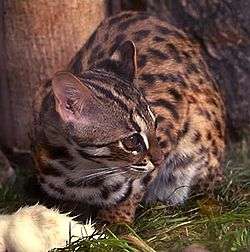
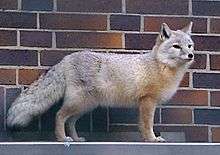
.jpg)
.jpg)
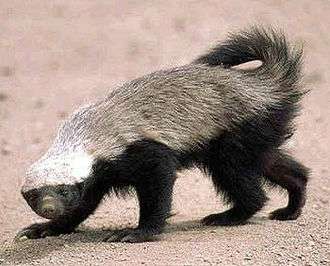
There are over 260 species of carnivorans, the majority of which eat meat as their primary dietary item. They have a characteristic skull shape and dentition.
The following species are listed as historically present:[6]
- Suborder: Feliformia
- Family: Felidae (cats)
- Subfamily: Felinae
- Genus: Caracal
- Genus: Felis
- Jungle cat, F. chaus LC[8]
- Asiatic wildcat, F. silvestris ornata
- Genus: Otocolobus
- Pallas's cat, O. manul NT[9]
- Genus: Lynx
- Eurasian lynx, L. lynx LC[10]
- Genus: Prionailurus
- Leopard cat, P. bengalensis LC[11]
- Subfamily: Pantherinae
- Genus: Panthera
- Persian leopard, P. pardus tulliana EN[12]
- Snow leopard, Panthera uncia EN[13]
- Genus: Panthera
- Subfamily: Felinae
- Family: Herpestidae (mongooses)
- Genus: Herpestes
- Indian grey mongoose, H. edwardsii LC[14]
- Javan mongoose, H. javanicus LC[15]
- Genus: Herpestes
- Family: Hyaenidae (hyaenas)
- Genus: Hyaena
- Striped hyena, H. hyaena LC[16]
- Genus: Hyaena
- Family: Felidae (cats)
- Suborder: Caniformia
- Family: Canidae (dogs, foxes)
- Genus: Vulpes
- Red fox, V. vulpes LC[17]
- Blanford's fox, V. cana LC[18]
- Corsac fox, V. corsac LC[19]
- Rueppell's fox, V. rueppelli LC[20]
- Genus: Canis
- Golden jackal, C. aureus LC[21]
- Gray wolf, C. lupus LC[22]
- Genus: Vulpes
- Family: Ursidae (bears)
- Genus: Ursus
- Brown bear, U. arctos LC[23]
- Asiatic black bear, U. thibetanus VU[24]
- Genus: Ursus
- Family: Mustelidae (mustelids)
- Genus: Mustela
- Least weasel, M. nivalis LC[25]
- Stoat, M. erminea LC[26]
- Genus: Vormela
- Marbled polecat, V. peregusna LC[27]
- Genus: Martes
- Beech marten, M. foina LC[28]
- Yellow-throated marten, M. flavigula LC[29]
- Genus: Meles
- Eurasian badger, M. meles LC[30]
- Genus: Mellivora
- Honey badger, M. capensis LC[31]
- Genus: Lutra
- European otter, L. lutra NT[32]
- Genus: Mustela
- Family: Canidae (dogs, foxes)
Order: Perissodactyla (odd-toed ungulates)
The odd-toed ungulates are browsing and grazing mammals. They are usually large to very large, and have relatively simple stomachs and a large middle toe.
- Family: Equidae (horses etc.)
- Genus: Equus
- Turkmenian kulan, Equus hemionus kulan EN - regionally extinct
- Persian onager, Equus hemionus onager EN - regionally extinct
- Genus: Equus
Order: Artiodactyla (even-toed ungulates)
The even-toed ungulates are ungulates whose weight is borne about equally by the third and fourth toes, rather than mostly or entirely by the third as in perissodactyls. There are about 220 artiodactyl species, including many that are of great economic importance to humans.
- Family: Suidae (pigs)
- Family: Moschidae
- Genus: Moschus
- Kashmir musk deer, Moschus cupreus EN
- Genus: Moschus
- Family: Cervidae (deer)
- Subfamily: Cervinae
- Genus: Cervus
- Central Asian red deer, Cervus affinis LC
- Genus: Cervus
- Subfamily: Cervinae
- Family: Bovidae (cattle, antelope, sheep, goats)
- Subfamily: Antilopinae
- Genus: Gazella
- Chinkara, Gazella bennettii LC
- Goitered gazelle, Gazella subgutturosa VU
- Genus: Gazella
- Subfamily: Caprinae
- Genus: Capra
- Wild goat, Capra aegagrus VU
- Markhor, Capra falconeri EN
- Siberian ibex, Capra sibrica LC
- Genus: Nemorhaedus
- Nemorhaedus goral NT
- Genus: Ovis
- Genus: Capra
- Subfamily: Antilopinae
See also
References
- Mohammadian, H. (2011). An Introduction to Mammals of Afghanistan. Tehran, Iran: Shabpareh Publishing Institute. ISBN 978-600-5038-15-6.
- Timmins, R. J.; Richardson, M.; Chhangani, A. & Yongcheng, L. (2008). "Macaca mulatta". IUCN Red List of Threatened Species. 2008: e.T12554A3356486. Retrieved 16 January 2020.
- Juste, J. & Paunović, M. (2016). "Myotis blythii". IUCN Red List of Threatened Species. 2016: e.T14124A22053297.CS1 maint: multiple names: authors list (link)
- Hutson, A. M.; Spitzenberger, F.; Juste, J.; Aulagnier, S.; Palmeirim, J.; Paunovic, M.; Karatas, A. (2010). "Hypsugo savii". IUCN Red List of Threatened Species. 2010: e.T44856A10955205.
- Juste, J. & Paunović, M. (2016). "Nyctalus leisleri". IUCN Red List of Threatened Species. 2016: e.T14919A22016159.CS1 maint: multiple names: authors list (link)
- Habibi, K. (2003). Mammals of Afghanistan. Coimbatore, India: Zoo Outreach Organisation, USFWS.
- Avgan, B.; Henschel, P.; Ghoddousi, A. (2016). "Caracal caracal". IUCN Red List of Threatened Species. 2016: e.T3847A102424310.
- Gray, T.N.E.; Timmins, R.J.; Jathana, D.; Duckworth, J.W.; Baral, H. & Mukherjee, S. (2016). "Felis chaus". IUCN Red List of Threatened Species. 2016: e.T8540A50651463.
- Ross, S.; Barashkova, A.; Farhadinia, M. S.; Appel, A.; Riordan, P.; Sanderson, J. & Munkhtsog, B. (2016). "Otocolobus manul". IUCN Red List of Threatened Species. 2016: e.T15640A87840229.
- Breitenmoser, U.; Breitenmoser-Würsten, C.; Lanz, T.; von Arx, M.; Antonevich, A.; Bao, W. & Avgan, B. (2015). "Lynx lynx". IUCN Red List of Threatened Species. 2015: e.T12519A121707666.
- Ross, J.; Brodie, J.; Cheyne, S.; Hearn, A.; Izawa, M.; Loken, B.; Lynam, A.; McCarthy, J.; Mukherjee, S.; Phan, C.; Rasphone, A. & Wilting, A. (2015). "Prionailurus bengalensis". IUCN Red List of Threatened Species. 2015: e.T18146A50661611.
- Stein, A. B.; Athreya, V.; Gerngross, P.; Balme, G.; Henschel, P.; Karanth, U.; Miquelle, D.; Rostro, S.; Kamler, J.F. & Laguardia, A. (2016). "Panthera pardus". IUCN Red List of Threatened Species. 2016: e.T15954A160698029.
- McCarthy, T.; Mallon, D.; Jackson, R.; Zahler, P. & McCarthy, K. (2017). "Panthera uncia". IUCN Red List of Threatened Species. 2017: e.T22732A50664030.
- Mudappa, D. & Choudhury, A. (2016). "Herpestes edwardsii". IUCN Red List of Threatened Species. 2016: e.T41611A45206787.
- Chutipong, W.; Duckworth, J. W.; Timmins, R.; Willcox, D. H. A. & Ario, A. (2016). "Herpestes javanicus". IUCN Red List of Threatened Species. 2016: e.T70203940A45207619.
- AbiSaid, M. & Dloniak, S.M.D. (2015). "Hyaena hyaena". IUCN Red List of Threatened Species. 2015: e.T10274A45195080.
- Hoffmann, M. & Sillero-Zubiri, C. (2016). "Vulpes vulpes". IUCN Red List of Threatened Species. 2016: e.T23062A46190249.
- Hoffmann, M. & Sillero-Zubiri, C. (2015). "Vulpes cana". IUCN Red List of Threatened Species. 2015: e.T23050A48075169.
- Murdoch, J.D. (2014). "Vulpes corsac". IUCN Red List of Threatened Species. 2014: e.T23051A59049446.
- Mallon, D.; Murdoch, J.D. & Wacher, T. (2015). "Vulpes rueppelli". IUCN Red List of Threatened Species. 2015: e.T23053A46197483.
- Hoffmann, M.; Arnold, J.; Duckworth, J. W.; Jhala, Y.; Kamler, J. F. & Krofel, M. (2018). "Canis aureus". IUCN Red List of Threatened Species. 2018: e.T118264161A46194820.
- Boitani, L. & Phillips, M. & Jhala, Y. (2018). "Canis lupus". IUCN Red List of Threatened Species. 2018: e.T3746A119623865.CS1 maint: multiple names: authors list (link)
- McLellan, B. N.; Proctor, M. F.; Huber, D. & Michel, S. (2017). "Ursus arctos". IUCN Red List of Threatened Species. 2017: e.T41688A121229971.
- Garshelis, D. L. & Steinmetz, R. (2016). "Ursus thibetanus". IUCN Red List of Threatened Species. 2016: e.T22824A114252336.
- McDonald, R. A.; Abramov, A. V.; Stubbe, M.; Herrero, J.; Maran, T.; Tikhonov, A.; Cavallini, P.; Kranz, A.; Giannatos, G.; Kryštufek, B. & Reid, F. (2019). "Mustela nivalis". IUCN Red List of Threatened Species. 2019: e.T70207409A147993366.
- Reid, F.; Helgen, K. & Kranz, A. (2016). "Mustela erminea". IUCN Red List of Threatened Species. 2016: e.T29674A45203335.
- Abramov, A.V.; Kranz, A. & Maran, T. (2016). "Vormela peregusna". IUCN Red List of Threatened Species. 2016: e.T29680A45203971.
- Abramov, A.V.; Kranz, A.; Herrero, J.; Krantz, A.; Choudhury, A. & Maran, T. (2016). "Martes foina". IUCN Red List of Threatened Species. 2016: e.T29672A45202514.
- Chutipong, W.; Duckworth, J.W.; Timmins, R.J.; Choudhury, A.; Abramov, A.V.; Roberton, S.; Long, B.; Rahman, H.; Hearn, A.; Dinets, V. & Willcox, D.H.A. (2016). "Martes flavigula". IUCN Red List of Threatened Species. 2016: e.T41649A45212973.
- Kranz, A.; Abramov, A. V.; Herrero, J. & Maran, T. (2016). "Meles meles". IUCN Red List of Threatened Species. 2016: e.T29673A45203002.
- Do Linh San, E.; Begg, C.; Begg, K. & Abramov, A. V. (2016). "Mellivora capensis". IUCN Red List of Threatened Species. 2016: e.T41629A45210107.
- Roos, A.; Loy, A.; de Silva, P.; Hajkova, P. & Zemanová, B. (2015). "Lutra lutra". IUCN Red List of Threatened Species. 2015: e.T12419A21935287.
External links
- "Animal Diversity Web". University of Michigan Museum of Zoology. 1995–2006. Retrieved 22 May 2007.


